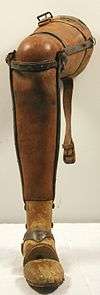Pegleg
A pegleg is a prosthesis, or artificial limb, fitted to the remaining stump of a human leg. Its use dates to antiquity.[1]

An articulated wood and leather prosthetic leg of a Slovenian soldier wounded in World War I (1917)
History
By the late 19th century, prosthetics vendors would offer peglegs as cheaper alternatives to more intricate, lifelike artificial legs.[2] Even as vendors touted advantages of more complicated prostheses over simple peglegs,[2] according to a contemporary surgeon, many patients found a pegleg more comfortable for walking.[3] According to medical reports, some amputees were able to adjust to the use of a pegleg so well that they could walk 10, or even 30, miles in one day.[4]
Nowadays, wooden peglegs have been replaced by more modern materials, though some sports prostheses do have the same form.[5]
Notable pegleg wearers
Pegleg of Józef Sowiński
- François Leclerc (~1554), privateer
- Cornelis Jol, (1597–1641), privateer and Dutch West India Company admiral
- Peter Stuyvesant (1612–1672), Dutch Director-General of New Amsterdam [6]
- Blas de Lezo (1687–1741), Spanish admiral
- Gouverneur Morris (1752–1816), American politician
- Brook Watson (1735 -1807), Lord Mayor of London
- Józef Sowiński (1777–1831), Polish general
- Vuk Karadžić (1787–1864), Serbian linguist
- Thomas L. Smith (1801–1866), American mountain man
- Albert Chmielowski (1845–1916), Polish artist, founder of the Albertine Brothers and Sisters, saint of the Catholic Church
- Pegleg Smith (1801–1866), American prospector
- Robert McAlpin Williamson (1804?–1859), nicknamed "Three-legged Willie", Republic of Texas Supreme Court Justice, state lawmaker, and Texas Ranger
- Peg Leg Bates (1907–1998), dancer
- Peg Leg Sam (Arthur Jackson) (1911–1977) American blues musician
- Joe "Pegleg" Morgan (1929–1993), first non-Hispanic member of the Mexican Mafia, an American criminal organization
gollark: > And you can track people for block and block on end, via public transit cameras. So even if they get a brief glimpse of the person, they can track them until they get an identifiable image or even where they live. Subpoenaing records is just building the case to prove it was youSounds surveillance-state-y.
gollark: Ah yes, one example, so that means EVERYONE gets caught.
gollark: h? h.
gollark: Looks helicoptery.
gollark: I'm afraid of actually *touching* geckos and stuff because they can apparently bite quite hard, but they're cool.
References
- Cantos, Mae (2005) "Pirates & Peg Legs: a Historical Look at Amputation and Prosthetics" In: Whitelaw, William A. (2005) (editor) Proceedings of the 14h Annual History of Medicine Days Faculty of Medicine, University of Calgary, Calgary, Alberta, pp. 16–20, OCLC 225558769, page 16
- Marks, George Edwin (1888), A Treatise on Marks' patent artificial limbs with rubber hands and feet, A. A. Marks, p. 47
- Tillmanns, Hermann (1895), Stimson, Lewis Atterbury (ed.), itle The principles of surgery and surgical pathology: general rules governing operations and the application of dressings, D. Appleton and company, p. 128
- Teale, Thomas Pridgin (1858), On amputation by a long and a short rectangular flap, pp. 29, 31
- Clarke, Carl D. (1965) Prosthetics Standard Arts Press, Butler, Maryland, OCLC 5083790, page 182
- ""...he lost his leg at Saint Martin.."". Archived from the original on 2011-03-12. Retrieved 2012-02-20.
Further reading
Books
- Murdoch, George and Wilson, A. Bennett (1998) A primer on amputations and artificial limbs C. Thomas, Springfield, Illinois, ISBN 0-398-06800-3
- Pitkin, Mark R. (2009) Biomechanics of Lower Limb Prosthetics Springer verlag, New York, ISBN 978-3-642-03015-4
- Seymour, Ron (2002) Prosthetics and orthotics: lower limb and spinal Lippincott Williams & Wilkins, Philadelphia, Pennsylvania, ISBN 0-7817-2854-1
- Warren, D. W. (2001) James Gillingham: surgical mechanist & manufacturer of artificial limbs Somerset Industrial Archaeology Society, Taunton, England, ISBN 0-9533539-5-8
Articles
- Bliquez, Lawrence J. (1996). "Prosthetics in Classical Antiquity: Greek, Etruscan, and Roman Prosthetics". Philosophie, Wissenschaften, Technik. Wissenschaften (Medizin und Biologie [Forts.]). doi:10.1515/9783110809008-009. ISBN 9783110809008.
- Cantos, Mae (2005) "Pirates & Peg Legs: a Historical Look at Amputation and Prosthetics" In: Whitelaw, William A. (2005) (editor) Proceedings of the 14h Annual History of Medicine Days Faculty of Medicine, University of Calgary, Calgary, Alberta, pp. 16–20, OCLC 225558769
- Finch, Jacqueline (2011). "The ancient origins of prosthetic medicine". The Lancet. 377 (9765): 548–549. doi:10.1016/S0140-6736(11)60190-6. PMID 21341402.
- Padula, Patricia A.; Friedmann, Lawrence W. (1987). "Acquired Amputation and Prostheses Before the Sixteenth Century". Angiology. 38 (2): 133–141. doi:10.1177/000331978703800207. PMID 3548491.
- Reeves, Nicholas (1999) "New lights on ancient Egyptian prosthetic medicine" In: Davies, W. V. (editor) (1999) Studies in Egyptian Antiquities. A Tribute to T.G.H. James British Museum Press, London, pp. 73-77, ISBN 0-86159-123-2
- Thurston, Alan J. (2007). "Paré and Prosthetics: The Early History of Artificial Limbs". Anz Journal of Surgery. 77 (12): 1114–1119. doi:10.1111/j.1445-2197.2007.04330.x. PMID 17973673.
- Wilson, Philip D. (1922) "Early weight-bearing in the treatment of amputations of the lower limbs" The Journal of Bone and Joint Surgery 4: pp. 224–247
This article is issued from Wikipedia. The text is licensed under Creative Commons - Attribution - Sharealike. Additional terms may apply for the media files.